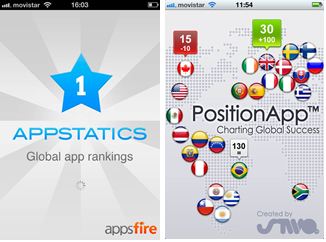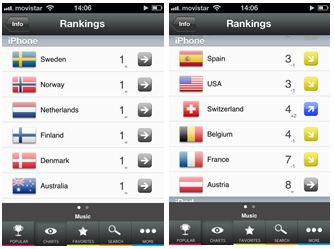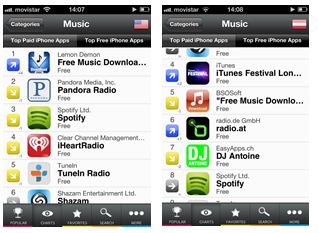TechCrunch reported in late July that the App Store has surpassed 650,000 apps. It therefore goes without saying that app visibility in itself has become an extremely challenging task.
Assuming you’ve already launched your app (which was hopefully accompanied by a carefully thought-out strategy to maximise exposure), it’s time to track its performance in the App Store.
In the case that your app is not restricted to a particular country, you may even want to know how it’s performing in the different countries you’re targeting. The good news is: There’s an app for that. Heck, there’s even two (and probably many more)!
Simple tracking of iOS app releases from your iPhone
In essence, Appstatics and PositionApp do much of the same (the latter was already launched in 2010). They crawl and collect data from the top 300 apps across all categories and countries in the App Store, which are then divided into paid and free apps. What’s particularly neat about Appstatics is the fact that developers can track their performance separately for iPhone, iPad as well as the Mac App Store.
Breakdown of country-by-country performance
Benchmarking an app’s performance between countries is a very useful feature provided it isn’t restricted by geography. Below, for example, you’ll find the country rankings of ultra popular music streaming service Spotify (service available in 15 countries worldwide) in the music category. I’m sure a company the size of Spotify has set up its own tracking tools, but for many less resourceful businesses this can provide a quick yet valuable overview of app performance.
An example is the historical data available. This comes in handy and can be used to measure your app’s performance on the country-level for a specified period of time – be that day, week or month. For example, this data might show a spike in Italy some three weeks ago which you otherwise wouldn’t have been aware of. Could this be due to press coverage from influential bloggers or journalists in Italy?
Hopefully, you’re using Google Alerts (or similar tools) to track at least the name of your app, but it’s still likely that any mentions in Italian (or any other language) wouldn’t have been picked up by this tracking tool. The historical performance data can indicate that something has occurred in a given country, which you can then set out to research yourself and, if deemed useful, incorporate it into your own communication to further build on that momentum.
Conversely, your app might have dropped in some markets. In that case, is there something you could you do to extend longevity in those countries where decreasing ranks have been identified?
Review competition
In the case of Spotify, it’s the most popular music app in many of its targeted countries (as can be seen above), however in France or Austria it’s not even in the top 5. Appstatics allows you to quickly identify your main competitors in different countries. For instance, as shown below, Spotify’s competitors in Austria differ largely from those in the US. Again, this allows you to employ different marketing tactics based on the insights you’ve gained on your position in different countries and the specific competitors you’re up against. As a market leader, you might be more concerned with retaining users and keeping them active, whereas increasing awareness might be the top priority in countries where you’re behind.
My app is not in the top 300 in any category – does it make sense for me to use it?
Taking into account the more than 650,000 apps in the App Store, being amongst the top 300 is in fact quite an achievement. While the usefulness of these apps invariably depend on whether you’re in the top 300, they remain powerful research tools for app developers whose apps have yet to break through this mark. For example, you’ll be able to answer questions like:
- What are the top performing apps in my category and country?
- What are their characteristics?
- Are there any prevailing user patterns and preferences? Do these seem to differ from mobile app consumers in other countries?
This is indeed valuable insight which can potentially help you identify and understand what triggers people in the specific market(s) you’re targeting. But just bear in mind that, with such fierce competition and massive supply, even the most brilliant app needs to be actively promoted – not only when launched but consistently.










